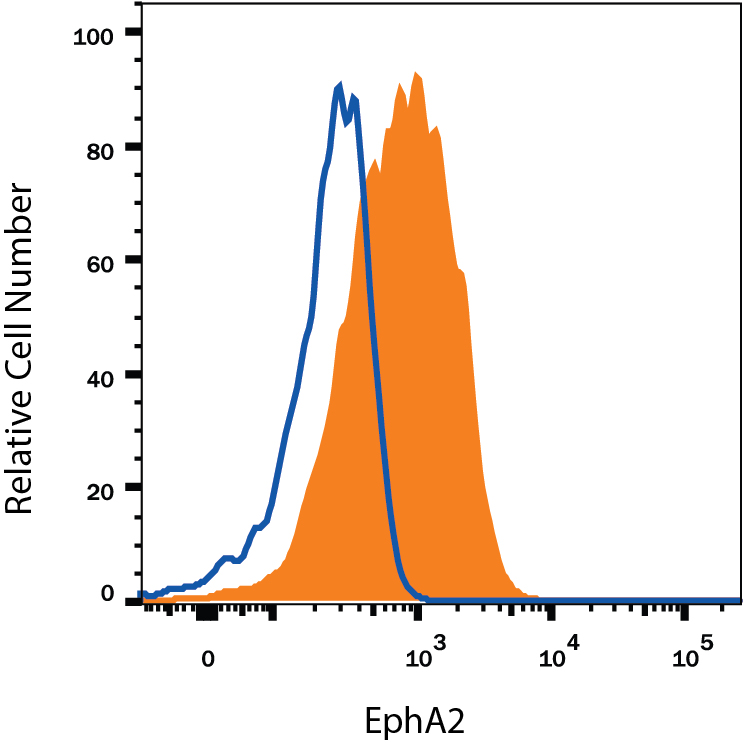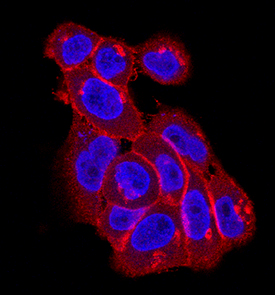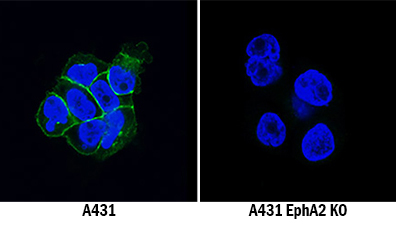Human EphA2 Antibody Summary
Gln25-Asn534
Accession # P29317
Applications
Please Note: Optimal dilutions should be determined by each laboratory for each application. General Protocols are available in the Technical Information section on our website.
Scientific Data
 View Larger
View Larger
Detection of EphA2 in A431 Human Cell Line by Flow Cytometry. A431 human epithelial carcinoma cell line was stained with Mouse Anti-Human EphA2 Monoclonal Antibody (Catalog # MAB3035, filled histogram) or isotype control antibody (Catalog # MAB003, open histogram), followed by Phycoerythrin-conjugated Anti-Mouse IgG Secondary Antibody (Catalog # F0102B). View our protocol for Staining Membrane-associated Proteins.
 View Larger
View Larger
EphA2 in A431 Human Cell Line. EphA2 was detected in immersion fixed A431 human epithelial carcinoma cell line using Mouse Anti-Human EphA2 Monoclonal Antibody (Catalog # MAB3035) at 10 µg/mL for 3 hours at room temperature. Cells were stained using the NorthernLights™ 557-conjugated Anti-Mouse IgG Secondary Antibody (red; Catalog # NL007) and counterstained with DAPI(blue). Specific staining was localized to the cell surface. View our protocol for Fluorescent ICC Staining of Cells on Coverslips.
 View Larger
View Larger
EphA2 Specificity is Shown by Immunocytochemistry in Knockout Cell Line. EphA2 was detected in immersion fixed A431 human epithelial carcinoma cell line but is not detected in EphA2 knockout (KO) A431 Human Cell Line cell line using Mouse Anti-Human EphA2 Monoclonal Antibody (Catalog # MAB3035) at 5 µg/mL for 3 hours at room temperature. Cells were stained using the NorthernLights™ 493-conjugated Anti-Mouse IgG Secondary Antibody (green; Catalog # NL009) and counterstained with DAPI (blue). Specific staining was localized to cell membranes. View our protocol for Fluorescent ICC Staining of Cells on Coverslips.
Reconstitution Calculator
Preparation and Storage
- 12 months from date of receipt, -20 to -70 °C as supplied.
- 1 month, 2 to 8 °C under sterile conditions after reconstitution.
- 6 months, -20 to -70 °C under sterile conditions after reconstitution.
Background: EphA2
EphA2, also known as Eck, Myk2, and Sek2, is a member of the Eph receptor tyrosine kinase family which binds Ephrins A1, 2, 3, 4, and 5 (1, 2, 3, 4). A and B class Eph proteins have a common structural organization. The human EphA2 cDNA encodes a 976 amino acid (aa) precursor including a 24 aa signal sequence, a 510 aa extracellular domain (ECD), a 24 aa transmembrane segment, and a 418 aa cytoplasmic domain. The ECD contains an N-terminal globular domain, a cysteine-rich domain, and two fibronectin type III domains (5). The cytoplasmic domain contains a juxtamembrane motif with two tyrosine residues, which are the major autophosphorylation sites, a kinase domain, and a sterile alpha motif (SAM) (5). The ECD of human EphA2 shares 90‑94% aa sequence identity with mouse, bovine, and canine EphA2, and approximately 45% aa sequence identity with human EphA1, 3, 4, 5, 7, and 8. EphA2 becomes autophosphorylated following ligand binding (6, 7) and then interacts with SH2 domain-containing PI3-kinase to activate MAPK pathways (8, 9). Reverse signaling is also propagated through the Ephrin ligand. Transcription of EphA2 is dependent on the expression of E-Cadherin (10), and can be induced by p53 family transcription factors (11). EphA2 is upregulated in breast, prostate, and colon cancer vascular endothelium. Its ligand, EphrinA1, is expressed by the local tumor cells (12, 13). In some cases, EphA2 and EphrinA1 are expressed on the same blood vessels (14). EphA2 signaling cooperates with VEGF receptor signaling in promoting endothelial cell migration (13). The gene encoding human EphA2 maps to a region on chromosome 1 which is frequently deleted in neuroectodermal tumors (15).
- Poliakov, A. et al. (2004) Dev. Cell 7:465.
- Surawska, H. et al. (2004) Cytokine Growth Factor Rev. 15:419.
- Pasquale, E.B. (2005) Nat. Rev. Mol. Cell Biol. 6:462.
- Davy, A. and P. Soriano (2005) Dev. Dyn. 232:1.
- Bohme, B et al. (1993) Oncogene 8:2857.
- Pandey, A. et al. (1995) Science 268:567.
- Bartley, T.D. et al. (1994) Nature 368:558.
- Pandey, A. et al. (1994) J. Biol. Chem. 269:30154.
- Miao, H. et al. (2001) Nat. Cell Biol. 3:527.
- Orsulic, S. and R. Kemler (2000) J. Cell Sci. 113:1793.
- Dohn, M. et al. (2001) Oncogene 20:6503.
- Zelinski, D.P. et al. (2001) Cancer Res. 61:2301.
- Brantley, D.M. et al. (2002) Oncogene 21:7011.
- Ogawa, K. et al. (2000) Oncogene 19:6043.
- Sulman, E.P. et al. (1997) Genomics 40:371.
Product Datasheets
Citations for Human EphA2 Antibody
R&D Systems personnel manually curate a database that contains references using R&D Systems products. The data collected includes not only links to publications in PubMed, but also provides information about sample types, species, and experimental conditions.
6
Citations: Showing 1 - 6
Filter your results:
Filter by:
-
A screen for Plasmodium falciparum sporozoite surface protein binding to human hepatocyte surface receptors identifies novel host-pathogen interactions
Authors: Segireddy, RR;Belda, H;Yang, ASP;Dundas, K;Knoeckel, J;Galaway, F;Wood, L;Quinkert, D;Knuepfer, E;Treeck, M;Wright, GJ;Douglas, AD;
Malaria journal
Species: Recombinant Protein
Sample Types: Protein
Applications: ELISA Capture -
Locoregional delivery of CAR T cells to the cerebrospinal fluid for treatment of metastatic medulloblastoma and ependymoma
Authors: LK Donovan, A Delaidelli, SK Joseph, K Bielamowic, K Fousek, BL Holgado, A Manno, D Srikanthan, AZ Gad, R Van Ommere, D Przelicki, C Richman, V Ramaswamy, C Daniels, JG Pallota, T Douglas, ACM Joynt, J Haapasalo, C Nor, MC Vladoiu, CM Kuzan-Fisc, L Garzia, SC Mack, S Varadharaj, ML Baker, L Hendrikse, M Ly, K Kharas, P Balin, X Wu, L Qin, N Huang, AG Stucklin, AS Morrissy, FMG Cavalli, B Luu, R Suarez, P De Antonel, A Michealraj, A Rastan, M Hegde, M Komosa, O Sirbu, SA Kumar, Z Abdullaev, CC Faria, S Yip, J Hukin, U Tabori, C Hawkins, K Aldape, M Daugaard, JM Maris, PH Sorensen, N Ahmed, MD Taylor
Nat. Med., 2020-04-27;26(5):720-731.
Species: Human
Sample Types: Whole Cells
Applications: Flow Cytometry -
Engineering of monobody conjugates for human EphA2-specific optical imaging
Authors: MA Kim, HS Yoon, SH Park, DY Kim, A Pyo, HS Kim, JJ Min, Y Hong
PLoS ONE, 2017-07-07;12(7):e0180786.
Species: Human
Sample Types: Whole Cells
Applications: Flow Cytometry -
Isolation and Characterization of a Monobody with a Fibronectin Domain III Scaffold That Specifically Binds EphA2.
Authors: Park S, Park S, Kim D, Pyo A, Kimura R, Sathirachinda A, Choy H, Min J, Gambhir S, Hong Y
PLoS ONE, 2015-07-15;10(7):e0132976.
Species: Yeast
Sample Types: Whole Cells
Applications: Flow Cytometry -
Quantitative assessment of antibody internalization with novel monoclonal antibodies against Alexa fluorophores.
Authors: Liao-Chan, Sindy, Daine-Matsuoka, Barbara, Heald, Nathan, Wong, Tiffany, Lin, Tracey, Cai, Allen G, Lai, Michelle, D'Alessio, Joseph A, Theunissen, Jan-Will
PLoS ONE, 2015-04-20;10(4):e0124708.
Species: Human
Sample Types: Whole Cells
Applications: Flow Cytometry, IHC -
Plk5, a polo box domain-only protein with specific roles in neuron differentiation and glioblastoma suppression.
Authors: de Carcer G, Escobar B, Higuero AM, Garcia L, Anson A, Perez G, Mollejo M, Manning G, Melendez B, Abad-Rodriguez J, Malumbres M
Mol. Cell. Biol., 2011-01-18;31(6):1225-39.
Species: Human
Sample Types: Cell Lysates
Applications: Western Blot
FAQs
No product specific FAQs exist for this product, however you may
View all Antibody FAQsReviews for Human EphA2 Antibody
There are currently no reviews for this product. Be the first to review Human EphA2 Antibody and earn rewards!
Have you used Human EphA2 Antibody?
Submit a review and receive an Amazon gift card.
$25/€18/£15/$25CAN/¥75 Yuan/¥2500 Yen for a review with an image
$10/€7/£6/$10 CAD/¥70 Yuan/¥1110 Yen for a review without an image

